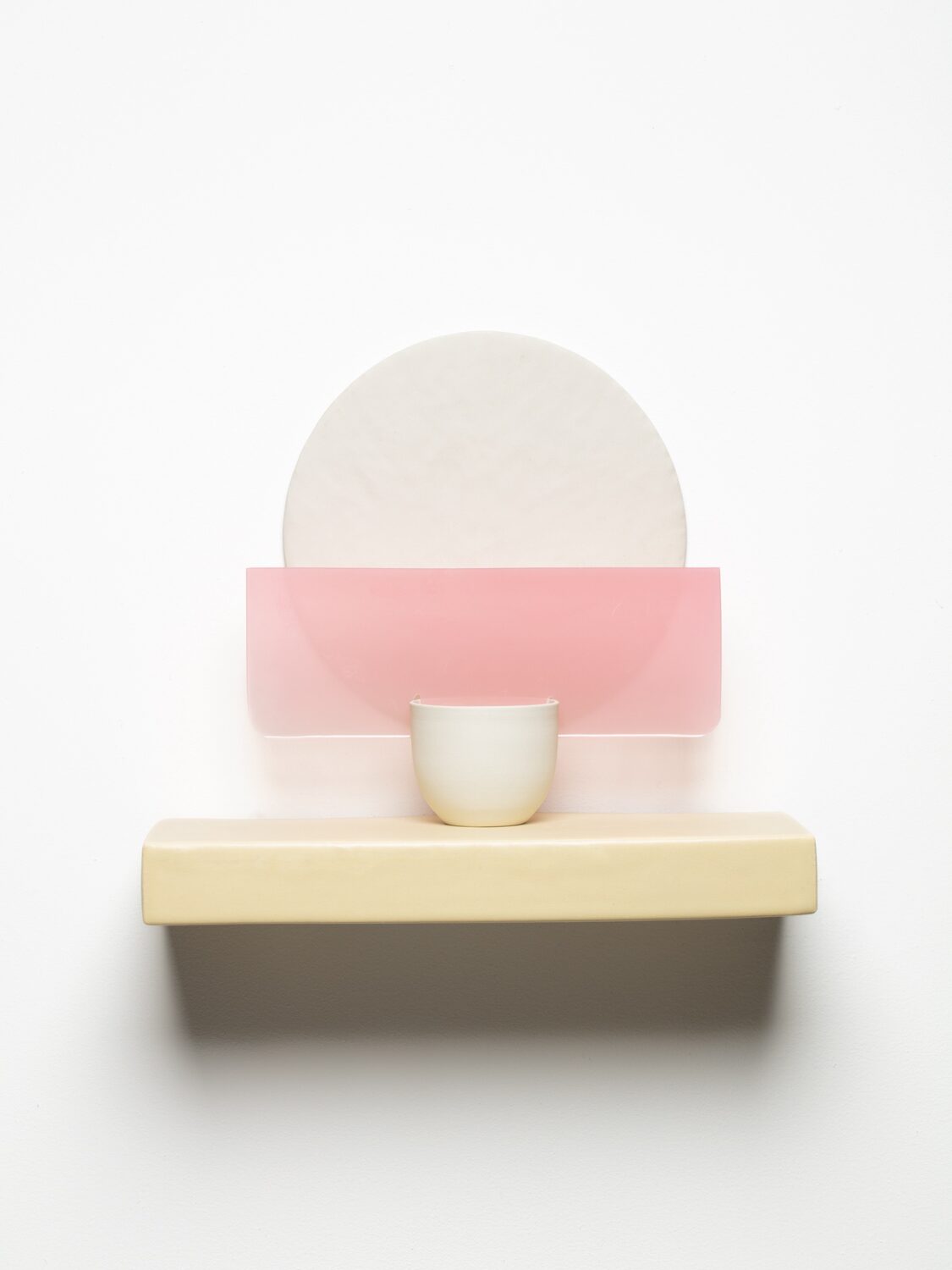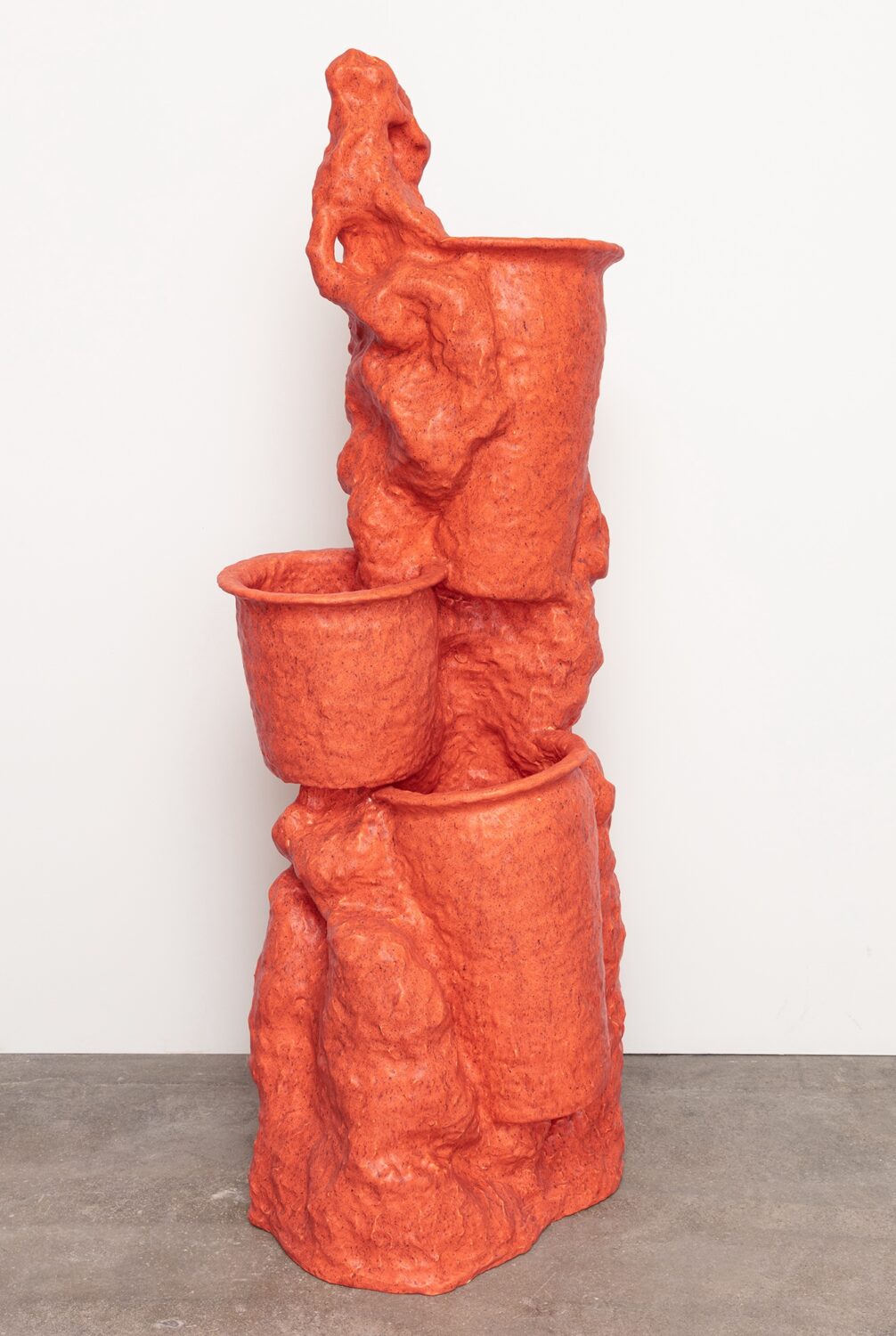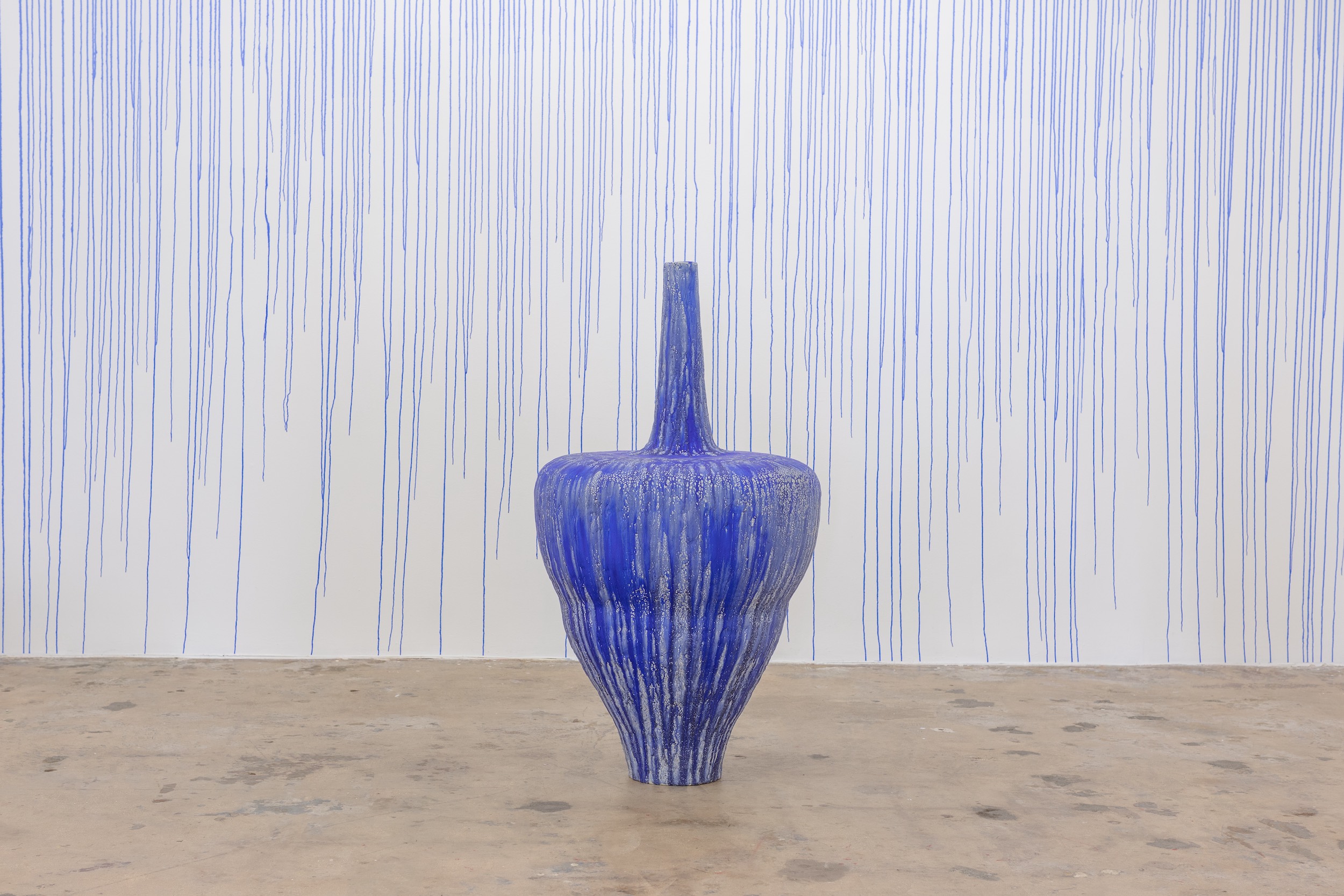‘I feel like a hybrid. Hopefully, the devil-may-care attitude that I have developed will remain while we’re in Denmark. That was a part of being an artist in the United States.’ Anders Ruhwald.
By we Anders Herwald Ruhwald (b. 1974) refers to himself and his wife, Marie Herwald Hermann (b. 1979). The story of their individual and shared journeys as artists is worth a listen for anyone curious about the life of an artist with an international outlook.
My first meeting with Anders and Marie was in their shared studio in Chicago. I was here on behalf of the Danish Arts Foundation’s fund for crafts and design with a fellow Danish curator with the purpose of networking with independent organizations and museums. After a long taxi ride to the outlying neighbourhood of Austin, the taxi driver dropped us off, a little reluctantly in an area dominated by grey, closed-down industrial buildings on a sunny spring day.
Anders and Marie have lived in Chicago since 2017 with their two children, both of them born in Detroit, where they lived from 2009 to 2017. The two artists met in the art metropolis of London. Raised on and shaped by Danish values, they have now decided to move back to Denmark. Partially, at least, since they want their children to experience the privilege of understanding multiple cultures and acquiring a hybrid identity. Partially, because they are going to maintain their careers and studio in Chicago. Marie is a tenured professor at the Art Institute of Chicago; her job was the reason why the family moved to the American city on the shores of Lake Michigan in 2017.
Roots and possibilities
‘My sculpture has roots in Denmark – that is undeniable. The language they speak is filtered through the Danish culture of art and design history. For example, I held a solo exhibition based on my recollection of the colours at Thorvaldsen’s Museum. This Danish background has one meaning when you’re working abroad – the question is how it will affect my work when I return to my roots.’
Marie Herwald Hermann.
Marie left Denmark at the age of 20 to study ceramic art at the University of Westminster and later earned a master’s degree at the Royal College of Art in London. Meanwhile, she established her name as a professional artist at an international level. After 24 years abroad, she is now moving, with her family, from the Windy City to the earth tones at Thorvaldsen’s Museum in Copenhagen.
‘We both trained abroad. In the US, we both held some of the highest positions in education. Where do your affinities lie? That is the question.’
Anders Ruhwald.
Anders left Denmark at the age of 29. An internship in 1998 with the Japanese-American artist Jun Kaneko (1942) only intensified his dream of going to the United States, and seven years later, the US was his home. He met Marie in 2005 at the Victoria and Albert Museum in London; an encounter that is as memorable as the renowned museum itself. For several years, they maintained a long-distance relationship punctuated by face-to-face meetings in Copenhagen, Chicago, London and Oslo – cities where they both hold exhibitions.
Marie lived in London, while Anders moved around Europe and the United States. During this time, they were both represented by the same gallery in Copenhagen.
‘I have always sought opportunities and been willing to travel to seize them. To explore something that seemed interesting, exciting. During my first five years in the US, that’s what drove me – applying for artist residencies, applying for teaching positions with facilities for my work.’
Anders Ruhwald.
In London, Anders had the opportunity of studying at the Royal College of Art, thus acquiring an international degree leading to several collaborations.
For Anders, London became a strategic opportunity to study at the Royal College of Art, earning him an international education. He has a solid CV of exhibitions in the Nordic countries, Germany and South Korea, which altogether opened the door to a permanent teaching position as Head of Department at Cranbrook Academy of Art in Michigan. The dream of the USA came true and the couple moved to Detroit together.
Teaching in the United States
The Cranbrook Academy of Art is one of the leading art schools in the United States. The academy has Scandinavian roots, close ties to the city and an on-campus art museum. The position allowed Anders to travel in connection with his own artistic practice, giving talks and holding exhibitions in both North America and Europe.
This possibility has a key impact on Anders’s ability to build a large network in the art world. Looking back at 30 years as an exhibiting artist, he finds that most of his solo exhibitions have been in the United States. Anders points both to his long-standing partnership with a gallery in Chicago and to his position at the School of the Art Institute of Chicago, where he taught before taking up the position at Cranbrook.
‘Both jobs were great platforms. I went to gallery openings, met the gallery owners, collectors and curators and invited them to my studio. Chicago and Detroit opened the US to me.’
Anders Ruhwald.
Marie became a department head and lecturer at the College for Creative Studies in Detroit and established herself with exhibitions in Chicago, Hong Kong and Paris – while her family grew from two to four. Like Anders, Marie also took a teaching position at The School of the Art Institute of Chicago.
‘The US art scene is very open to immigrants. We have been a part of the culture for years. If you live there, you are considered an American.’
Marie Herwald Hermann.
They both enjoy teaching, but also have an unwritten rule to take turns having a steady income. The family waited for Marie’s full-time employment as a professor before moving to Chicago.

Ceramic practice
Anders and Marie have their roots in ceramic art. They share this field and a studio, but they each have their individual practice. Anders creates installations that span across art history references and everyday objects. Marie balances still lifes across time and lived experience.
‘In the United States, you are employed because of your practice – you continually need to develop your work and exhibit. I have deliberately always applied for teaching positions that offer good studio facilities and the right conditions to focus on my work.’
Anders Ruhwald.
With the teaching position in Detroit, Anders is handed a large studio space. This has a crucial impact on his artistic practice. He taps into American culture and its long-standing tradition for monumental art installations. A passionate art collector showed interest in a large-scale installation that Anders – and we Europeans – find hard to imagine. Unit 1: 3583 Dubois is a site-specific art installation in Detroit that encompasses an entire multi-level apartment which seems as if it has been ravaged by fire.. The time in Detroit becomes defining for Anders.
‘My ideas always begin with clay.’ Marie Herwald Hermann.
Unlike Anders, Marie left Denmark early. Thus, her entire professional career is internationally based. After being awarded the Danish Arts Foundation’s three-year working grant, she moved from a small room in England to a large studio in Detroit. Marie’s work develops and expands.

‘I began to envision works in new materials – wood, metal, silicone.’ Marie Herwald Hermann.
The international outlook has always been palpable to Marie. The culture in England and the United States presents her with possibilities and dialogues between aesthetic disciplines and the open potential of the artistic environment that shapes her artistic manifesto.
‘We were really privileged and have always had access to large studios which provide us with a physical setting that did not feel constraining.’
Anders Ruhwald.

Art and love
Anders and Marie are life partners, and as a couple, they felt it was necessary not to be represented by the same gallery. Family comes first, and during the time leading up to big exhibition openings, they need to prioritize their time. They know each other’s processes and know that at times, their work does not allow for a conventional family life.
‘It’s a huge privilege to be able to discuss your practise with your partner. To talk about the work, especially when you feel uncertain. Sometimes Anders sees things in my works before I become aware of them.’
Marie Herwald Hermann.
The reality of selection becomes inevitable when you are part of the same scene. The experience of being left behind when cultural institutions favour your partner over you. Both Anders and Marie have had this experience; felt how the disappointment builds viscerally and disturbs the feelings of happiness for the other. Their mutual feelings of respect and love lay a special foundation for their shared life as artists.
‘The intimacy of sharing your life with another person. Being an artist is often lonely. Sharing this journey is unpredictable. Using each other to balance our uncertainties. Reminding each other why we do what we do – where the qualities lie.’
Anders Ruhwald.

Unrestricted outlook
‘The shift from the US to Denmark is also a shift in proportions: the art scene is smaller, the studios are smaller – it’s going to be a challenge to find room, both physically and mentally.’
Anders Ruhwald.
The move to Denmark gives the couple cause to reflect and insist on an unrestricted outlook. To Anders, the practical concerns are based on a fear of limitations. How can he continue to dream big when everything feels smaller? Marie’s concerns are culturally based since she is not yet an established name in Denmark.
‘Because I wasn’t trained in Denmark, I come in with a different disciplinary structure and culture, so I am curious about Danish dialogues across materials.’
Marie Herwald Hermann.
Both Anders and Marie look forward to discovering whether this cultural context and the local production of art can inspire new dialogues and connections. Whether the national and local environment in Denmark can expand the outlook for artists with hybrid identities. They have hope and expectations for the contemporary art scene.
‘Now I will have to see if Denmark is still the same country I left.’ Anders Ruhwald.
Currently, Anders is working at the National Workshops for Art to prepare for a solo exhibition in 2025 at Andersen’s Contemporary in Copenhagen. Marie recently finished her contribution to an upcoming book about the German-born American sculptor Ruth Duckworth and is working on a solo exhibition at Broadway Gallery in New York to open in spring 2025.
Anders & Marie
Anders Herwald Ruhwald
2025: Soloudstilling at Moran Moran, Los Angeles
2025: Soloudstiling at Andersen’s Contemporary, KBH
2026 Soloudstilling at Nina Johnson, Miami
2027: Solo udstilling at Rudolph Tegners Museum, Dronningmølle
2024-27: Danish Arts Foundation’s Committee for Craft and Design Funding
2024-25 John Simon Guggenheim Memorial Foundation Fellowship
Marie Herwald Hermann
2025: Soloudstilling at Broadway Gallery, New York
2025: Soloudstilling at Rebecca Camacho Gallery, San Francisco
2026: Soloudstilling at Mindy Solomon Gallery, Miami
Associate Professor at the School of the Art Institute of Chicago
Theme: Outlook
Artist-in-residence, exhibitions and competitions in international contexts have always been part of the DNA of craft artists and designers. What stories do they take with them? What knowledge do they bring back home?
Stay tuned for our ongoing releases.


